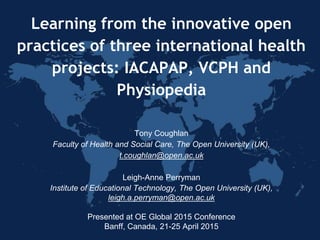Learning from the innovative open practices of three international health projects: IACAPAP, VCPH and Physiopedia
- 1. Learning from the innovative open practices of three international health projects: IACAPAP, VCPH and Physiopedia Tony Coughlan Faculty of Health and Social Care, The Open University (UK), t.coughlan@open.ac.uk Leigh-Anne Perryman Institute of Educational Technology, The Open University (UK), leigh.a.perryman@open.ac.uk Presented at OE Global 2015 Conference Banff, Canada, 21-25 April 2015
- 2. Global shortfall of healthcare workers ŌĆśA crisis in human resourcesŌĆÖ ŌŚÅ 2013: 7.2 million shortfall ŌŚÅ 2035: 12.9 million shortfall Source: World Health Organisation. Photo: Exceed Worldwide CC-BY-NC:
- 3. ŌŚÅ Focus on specific health professions ŌŚÅ Have links with professional bodies ŌŚÅ Use volunteers and are non-profit ŌŚÅ Aim to share expertise ŌŚÅ Play an international role including in LICs ŌŚÅ Are based outside HE ŌŚÅ Use CC licenses ŌŚÅ Use social media The projects...
- 4. The projects... Collaborative open textbook International Association for Child and Adolescent Psychiatry and Allied Professions ŌŚÅ Est. 75 years ago ŌŚÅ 63 member organisations
- 5. The projects... The Virtual Campus of Public Health (VCPH) ŌŚÅ Launched 2003 ŌŚÅ 140+ partner institutions in Central & S. America
- 6. The projects... Physiopedia ŌŚÅ Est. 2009 ŌŚÅ At its heart - wiki developed by a community of physiotherapists
- 8. Prof. Joseph M. Rey Head of Psychiatry at Sydney Medical School, Notre Dame University, Australia. Founder of IACAPAP textbook.
- 9. Edgardo de Gracia System analyst & designer at Ministry of Health, Panama VCPH national consultant
- 11. ŌŚÅ CC-BY ŌŚÅ 49 Chapters ŌŚÅ English & French ŌŚÅ Fully interactive ŌŚÅ 60,000 visits in first 3 years ŌŚÅ Facebook IACAPAP Textbook
- 12. IACAPAP Textbook Innovation ŌĆó Collaborative, cross-continent textbook production ŌĆó 100+ authors, 24 countries, 5 continents ŌĆó Dynamic ŌĆō ongoing updating and feedback
- 13. IACAPAP Textbook ŌĆ£The main thing is that it facilitates access. In many countries, if child psychiatrists donŌĆÖt have access to open resources like our textbook they donŌĆÖt have access to any resources at all. ItŌĆÖs not merely a case of saving money. ItŌĆÖs having nothing, or having something.ŌĆØ
- 14. ŌŚÅ 100+ institution collaboration ŌŚÅ 190,000 item multilingual online library (5800 OER) ŌŚÅ 14 open courses ŌŚÅ MOOCs ŌŚÅ Open policies ŌŚÅ Facebook VCPH
- 15. VCPH Innovation ŌĆó Multilingual: Spanish, Portuguese & English ŌĆó Localised for culture and language ŌĆó Open policies
- 16. VCPH ŌĆ£We use open practices to promote equity in health, to combat disease and improve the quality of lives of people of the Americas. While openness is not all- pervasive in public- health institutions in Central and Southern America VCPH hopes to change the culture.ŌĆØ
- 17. ŌŚÅ Wiki: 1400 articles; 150,000+ users from 200+ countries per month ŌŚÅ Open badges ŌŚÅ Open courses ŌŚÅ MOOC ŌŚÅ GFDL + CC-BY- NC-SA Physiopedia
- 18. Physiopedia Innovation ŌĆó Health profession capitalising on Web 2.0 ŌĆó Professional wiki ŌĆó Open badging ŌĆó Big impact/very small team
- 19. Physiopedia ŌĆ£A lot of people who use our content donŌĆÖt otherwise have any access to this kind of information - theyŌĆÖre in low-income countriesŌĆ”Being open enables these people to use up-to-date resources and achieve impact on clinical practiceŌĆØ
- 20. Implications ŌĆó Existing conception of open educational practices is too embedded in universities and individual students ŌĆó These projects: OEP = vocational learning & institutional collaboration ŌĆó Need for new frameworks to capture this, plus impact and localisation. ŌĆó Is this unique to health?
- 21. Thank you for listening Tony Coughlan Faculty of Health and Social Care, The Open University (UK), t.coughlan@open.ac.uk @tjcoughlan Leigh-Anne Perryman Institute of Educational Technology, The Open University (UK), leigh.a.perryman@open.ac.uk @laperryman
Editor's Notes
- #2: Who we areŌĆ” academics with UKOU. For some years weŌĆÖve been researching OER and OEP outside academia, partly in connection with our development of the public open scholar role. IŌĆÖm OERRH fellow, specialising in OER in developing countries. TonyŌĆÖs specialism is health & social care. Developed and runs cyp-media.org ŌĆō site curating digital open resources for the children and young peopleŌĆÖs workforce sector. This presentation reports our research on three international health projects engaged in innovative open practices.
- #3: The impetus for this research is a real and pressing global problemŌĆ”.
- #8: B We analysed the projects against two frameworksŌĆ” OPAL OEP maturity matrix which coversŌĆ”. However this wasnŌĆÖt sufficiently comprehensive to cover the practices in the three global health projects. We appended it with Vrieling et alŌĆÖs OEP social configuration framework which looks at: Practice: The impact on occupational activity. Domain: ŌĆ£The shared area in which group members work together. Collective identity: ŌĆ£The mutual engagement that binds the members together as a social entity, Organization: The interactional repertoire of a group of people, the geographical scope of its activities, the power relations involved, and the level of self-organisation.
- #9: T
- #10: T
- #11: T
- #12: T Collaborative, cross-continent textbook production 100+ authors, 24 countries, 5 continents Dynamic ŌĆō ongoing updating and feedback
- #13: T Collaborative, cross-continent textbook production 100+ authors, 24 countries, 5 continents Dynamic ŌĆō ongoing updating and feedback
- #14: T Collaborative, cross-continent textbook production 100+ authors, 24 countries, 5 continents Dynamic ŌĆō ongoing updating and feedback
- #15: T
- #16: T
- #17: T
- #18: T
- #19: T
- #20: T
- #21: B
- #22: Our full paper is available in the conference issue of OpenPraxis.





















